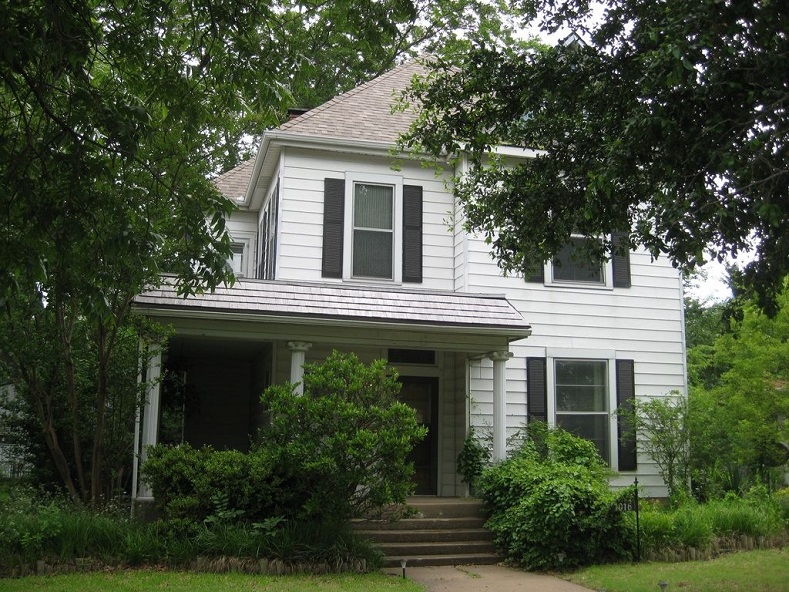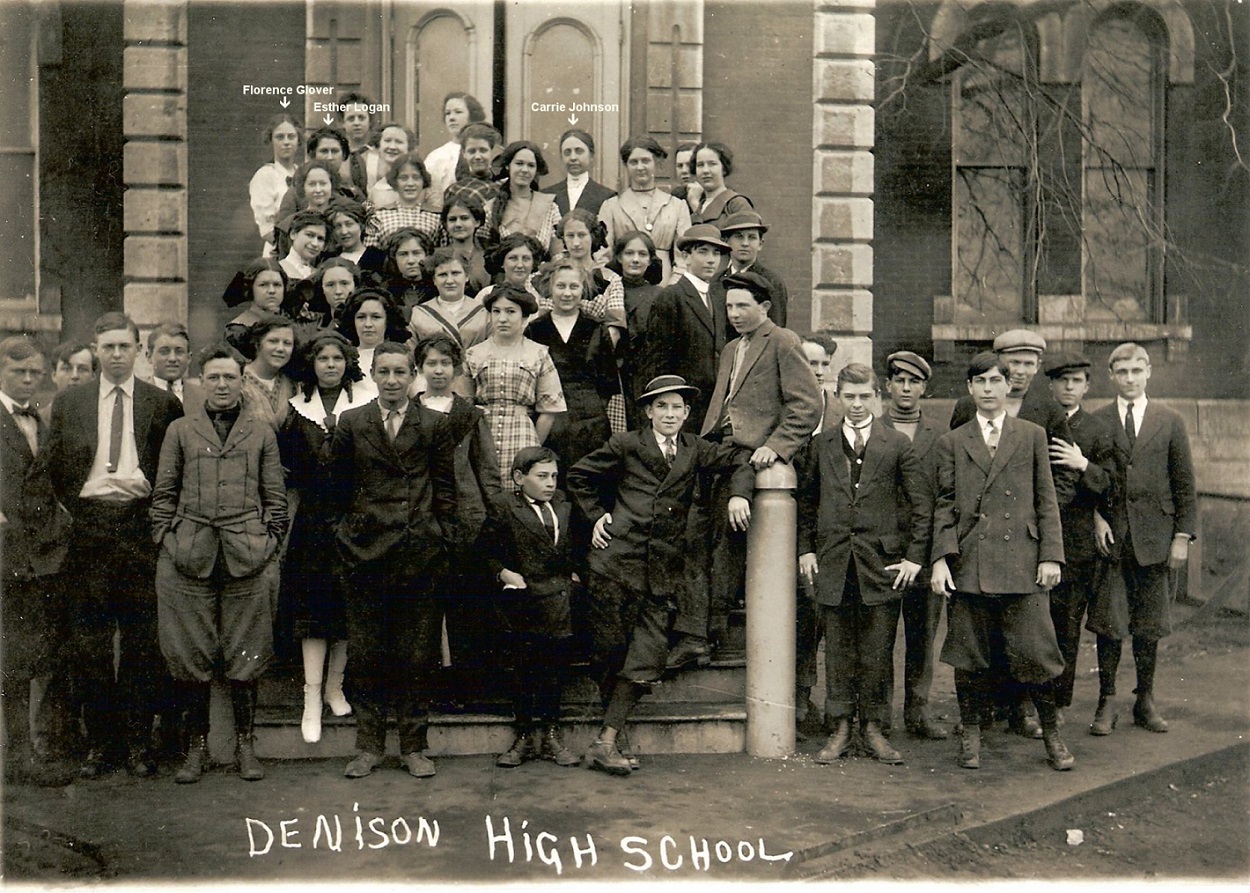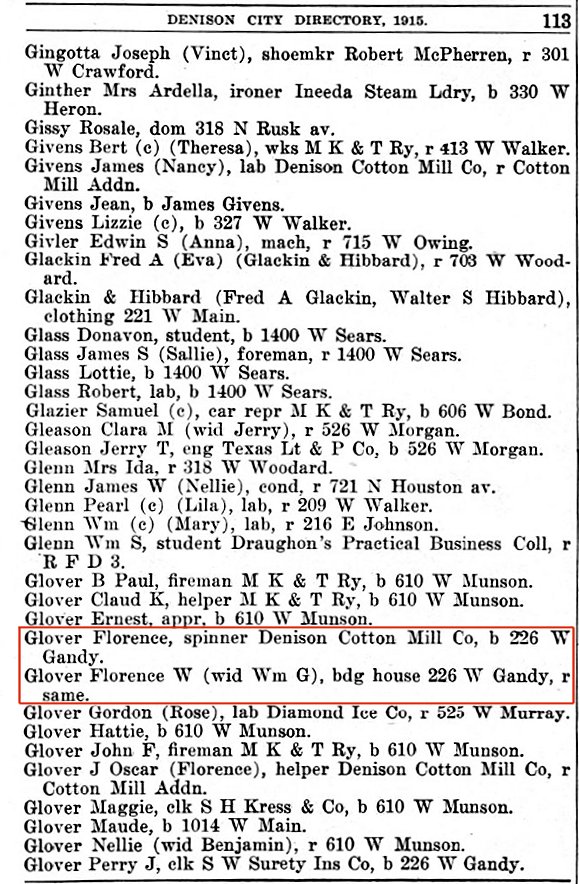
Cotton Mill Florence Glover Doe
--West, Hedy. “Cotton Mill Girls.” Hedy West. Vanguard, 1963. LP. In the summer of 1915 one of the girls in the spinning room of the Denison Cotton Mill was Florence Glover. Nineteen years old and single, she was living with her widowed mother on Gandy Street, three houses east of Rusk Avenue. Mrs. Glover, whose first name was also Florence, had been running a boarding house in her home since the death of her husband William 17 years earlier. Around 1896 they had moved from Marshall in East Texas to Denison, where he began working as a messenger for the American Express Company. When he died two years later at the age of 46, he left his widow with five-year-old Perry and two-year-old Florence. Mrs. Glover's first boarding house is listed in the 1901 City Directory at 101 West Sears Street. By 1903 she had moved to 226 West Gandy. Perry and Florence attended Stevens and Burleson schools. One of Florence's closest friends and classmate was Esther Louise Logan (1895-1996). Florence may have spent many happy afternoons in the home of her friends.
Although neither of their names appears in surviving lists of Denison High School graduates, Florence is listed with other students (Fred Tobin, Murray Tucker, Gladys Shaw, Helen Merrill, Ralph Ellis, John Clark, Esther Logan) in Room 3 of the high school in a newspaper article dated March 25, 1911. Esther and Florence were ushers at the piano recital of Silia Iisenhour, another good school friend, in the spring of 1911.
She was 15 at the time. Florence graduated from the Educational Institute in 1913, along with her close friend Esther Logan; Esther, an only child, had lived with her closest friend, Norinne Sullivan, and her family during her senior year. Florence continued her education at Wellesley College in Massachusetts while Esther attended The College of Industrial Arts (later known as Texas Women's University) in Denton, Denton County, Texas.
In 1915 Perry had finished high school, attended Texas A&M for two years, and taken a clerk position in an insurance office on Main Street in Denison. Florence was home for the summer, working to earn money to pay for her junior year at college. She could walk two or three blocks from the boarding house and catch the Interurban going west on Main, then south on Mirick Avenue to the Cotton Mill. The distance was a little more than two miles.
Florence's job as a spinner was to move quickly up and down the row between two spinning frames, pausing to repair breaks and snags in the threads that were being wound around hundreds of bobbins on each frame. She endured choking dust and lint, along with overwhelming summer heat and humidity, amid the deafening noise inside the mill. In 1907, just eight years earlier, the employees' workday at the mill had been reduced from thirteen hours to ten. Florence was paid around ten cents an hour, which amounted to about a dollar a day. Her wages for the entire summer's work could not have totaled much more than $70.
National Child Labor Committee Collection The cost of tuition, room, and board at Florence's school was $500 a year. Some of that expense may have been covered by money her mother had put aside from her boarding house earnings. The school was Wellesley College in Massachusetts. Within a decade or so of its founding in 1870 it had become the preeminent female seminary in the country, if not the world. To this day it frequently tops the lists of best women's colleges in America. Scholarships were available for students of modest means, but most of the young women at the school were from relatively wealthy families in the Northeast. How Florence came to enroll there is a mystery. Whatever the story, it seems likely that she is one of the few Wellesley women ever to work in a cotton mill. Florence's graduating class of 1917 is known primarily for two things. One is that it was “the last class to know the original Wellesley College.” The main building, a grandiose structure that took four years to build in the early 1870s, burned in March of the class's freshman year. The well-drilled students escaped the flames, but the building was a total loss, and the college had to be almost completely rebuilt. A photograph of old College Hall helps to comprehend the enormity of the 1914 loss. 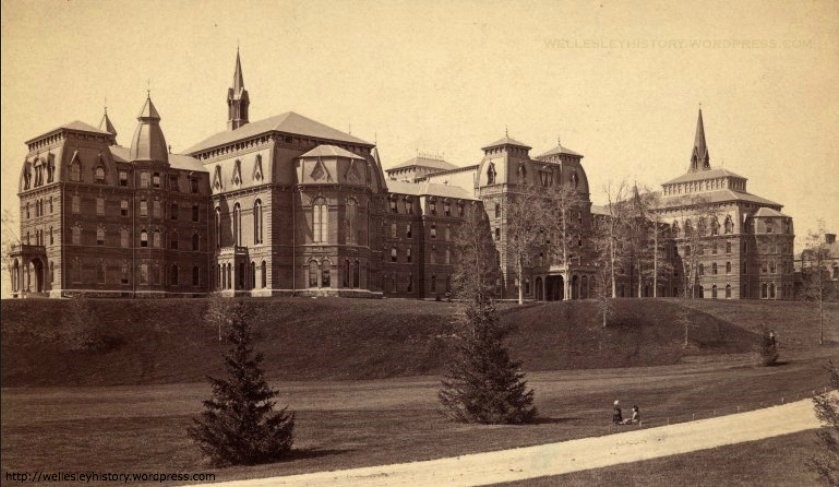
College Hall
The second thing for which the class of 1917 is known is the renown of one of its members, a young woman from Shanghai, China. She and her two older sisters, graduates of Wesleyan College in Georgia, were among the first Chinese women to be educated in America. The Soong sisters played important roles in shaping the history of China in the 20th century.
Ai-ling Soong married the richest man and finance minister of China, H.H. Kung. Ching-ling Soong married Sun Yat-sen, the “Father of Modern China” and the first President of the People's Republic of China. Florence Glover's classmate, Mei-ling (or Mayling) Soong, married the Commander in Chief of the Chinese armies, who later became President of the Republic of China. Mei-ling is better known to us as Madame Chiang Kai-shek. Two
recent United States Secretaries of State, Madeleine
Albright and Hillary Clinton, are both Wellesley alumnae. Unless Secretary Clinton succeeds in her bid to be elected
President, Madame Chiang Kai-shek will probably remain the school's most
famous alumna. She is pictured below at
the 25th reunion of Wellesley's class of 1917.

http://www.wellesley.edu/msc/chiangkaishek
Not
long after Florence graduated from Wellesley in the spring of 1917,
her brother Perry moved from Denison to Oklahoma City. For the next
decade, he lived successively in Muskogee, Oklahoma City, and Tulsa
At the end of the 1920s he moved again to Denver, where he died
in 1959. Their mother, Florence
Nettie Woodlan Glover, left Denison around the same time as Perry. She
moved
back to her native Callaway County, Missouri, where she died in 1954.
Her body
was sent back to Denison to be buried next to her husband's in Fairview
Cemetery.
Also interred near William Glover is his mother, Mary Jane Perry
Glover. Her
body was transported in 1900 from Fort Worth to Denison to be buried
next to
her son, according to her wish. Her husband, William's father, is
buried in
Kentucky. He died in 1853 at age 36, leaving Mary Jane a 27-year-old
widow with
a one-year-old son.
Florence Glover stayed in the Boston area after she finished college. In January 1920 the U. S. Census found her living in a boarding house in South Boston and employed as a social worker doing settlement work with immigrants. A month later she married Orlando Cutler Doe (1892-1968), a Dartmouth graduate who had established a farm in 1915 near one of Boston's western suburbs. He had previously married Wellesley alumna Olive Locke in December of 1916, but she died the following year. Although it is possible that Florence knew Orlando through Olive, it may be more likely that she met him through his sister Janet, another of her classmates in the Wellesley class of 1917. In the 1920s Florence and Orlando had two sons and a daughter. All three would go on to graduate from college--William and Whitney from Cornell, Ellen from Vassar. The boys returned home to help their father run the family farm. They and their sister are now deceased, but the current generation of the Doe family is still farming and still doing a lively business. 
Florence Glover Doe died in 1988 at age 92. We don't know whether she ever returned to Denison. She might have come back shortly before Thanksgiving in 1954 to see her mother laid to rest in Fairview Cemetery. If so, and if she went by her old address on Gandy Street, she would have noticed that the two-story boarding house had been replaced by a one-story house. Red River Trophy & Engraving is there now. If she looked for her old schools, she would have found Stevens and Burleson both gone. The old high school, brand new when she was a sophomore at Wellesley, had been converted to a junior high earlier in 1954. The only remaining traces of the Interurban would have been the few tracks that had not yet been taken up or paved over. Going south on Mirick Avenue she would have passed a new high school that had opened earlier that fall. When she finally reached the Cotton Mill, she would have found it still there and still operating. Perhaps it would have looked about the same, but after nearly 40 years she might have noticed changes in it, too. What would she have thought as she stood there and gazed at it? What images would have rushed back from that summer of 1915? We can't know the answers to those questions, of course, but we can get glimpses inside other cotton mills in the South in the early 1900s, thanks to a series of photos taken by Lewis Wickes Hines (1874-1940) in the course of his investigation for the National Child Labor Committee. Many of his photos are included in the following YouTube video, backed by an audio track of Candace Corrigan's rendition of “Cotton Mill Girls.” You can click to skip the rest of the ad after the first five secondsAddendum After I finished the preceding six pages, I shared them with one of Florence Glover's grandchildren, Thomas G. “Tom” Doe of Concord, Massachusetts. I found him on Ancestry.com. He wrote me back and suggested that we schedule a telephone call to talk about his grandmother. In the meantime he conferred with his sisters and cousins to find out what they remembered about her. He called last week, and we talked for about 45 minutes. By the time we finished, I had learned several new things about Florence. The consensus in the Doe family is that Florence had a family connection, possibly a grandfather, who steered her toward Wellesley and who helped to finance her education there. As I mentioned earlier, Florence's three children are all dead now, and her grandchildren do not know much about the Glover side of their family. They do not know what brought them to East Texas or why they moved from there to Denison. They also do not know how Will Glover, Florence's father, died in 1898 at the age of 46. They do not recall their grandmother talking much about growing up in Denison. No photos, letters, or other memorabilia connecting her to Denison are known to have survived her. Her family did not know about Florence's mother's boarding houses or about Florence working at the cotton mill, but Tom said they were excited to have that information. He does not know whether she ever returned to Denison after she moved away. He hopes to go there himself later this spring in conjunction with a planned trip to the Dallas area. Although they do not know many details of Florence's early life, her Massachusetts family members have always been well aware of where she came from. Their affectionate nickname for her was “Tex.” They take pride in the fact that the girl from Texas was not only a classmate of Mei-ling, the future Madame Chiang Kai-shek, but also one of her closest friends at Wellesley. A story Florence was fond of telling hints at a possible basis for their friendship. Shortly after her arrival at Wellesley, she was standing in a registration line when a girl in front of her turned and introduced herself. Upon hearing where Florence was from, the girl responded, “Texas! Did you live in a soddy there?” To their other classmates Florence must have seemed almost as exotic as the girl from China. Mei-ling came to Wellesley from Macon, Georgia, where she had lived for four or five years while her two older sisters were attending Wesleyan College. The Soong sisters learned to speak English with a Southern accent. Florence's Texas twang and Mei-ling's soft Georgia drawl and Oriental appearance placed them both in the category of students from “a whole ‘nuther country.” That sense of being different from the other girls may have contributed to the bond that formed between the two. Tom told me that on one occasion when Madame Chiang returned to the United States for a visit, she presented his grandmother with a Chinese tea set, which she treasured for the rest of her life. He has the set now. Tom followed up our phone conversation with an email, in which he wrote that Florence once told his sister that she learned to play bridge at an early age. By the time she got to Wellesley she possessed such skill as a player that faculty members began to invite her to their homes to play. She enjoyed the unusual student privilege of being exempted on such occasions from school rules governing being off campus and staying out after curfew. One wonders where and with whom Florence learned to play bridge while growing up in Denison. One possibility might be the XXI Club, which was just six blocks west of Mrs. Glover's boarding house on Gandy Street. The club also housed the town's only public library at the time, and that may have led Florence to spend time there as well. A 1911 story in The Sunday Gazetteer about a piano recital at the XXI Club listed Florence Glover as one of the ushers. She was 15 at the time. Tom said that his grandfather was also an avid bridge player. He and Florence taught Tom how to play. The settlement house where Florence lived and worked in Boston was coincidentally named Denison House. It was founded in 1892 by a group of Wellesley women and named for Edward Denison, an Englishman who had worked to establish a settlement in London in the 1870s. Although he had no known connection to George Denison, the man for whom Florence's hometown was named, the two men could have had common ancestors in England two or three centuries earlier. The purpose of Denison House was to provide social services and education to the urban poor by having educated women and poor people live together in the same residence. The most famous resident of Denison House was Amelia Earhart, who lived there from 1925 to 1928. Tom confirmed that Florence and his grandfather, Orlando C. Doe, were introduced by Orlando's sister and Florence's 1917 classmate, Janet Doe. Janet went on to have a distinguished career as a pioneering medical librarian. In later years Florence took an interest in and volunteered as a docent at the Fruitlands Museum, not far from the Doe farm. The museum opened in 1914 on the former site of a failed Utopian community that was founded in the 1840s by Louisa May Alcott's father, Bronson Alcott. The founder of the museum itself was Clara Endicott Sears (no known relation to me), a New England heiress who was also an author, philanthropist, and preservationist. Clara Endicott Sears and the Fruitlands Museum are each the subject of a Wikipedia article. I sent Tom a copy of Mavis's undated group photo (below) of students at Stevens School. I took it from Elaine's website. Although it is not dated, I think there is a fairly high probability that it was taken in 1907 or 1908. Mavis wrote in the website's biography of photographer Jackson E. Hendricks that his advertisements in the DHS magazine, The Raven, appeared with Sherman telephone numbers in those two years. The photo below is inscribed “New Phone Sherman, Tex.” Although the woman in the picture resembles Miss Carrie Johnson, the high school teacher, she is actually Carrie's younger sister, Miss E. Pearl Johnson. Both women lived in 1907 with their widowed mother at 1505 W. Gandy Street. The Sunday Gazetteer reported in June of 1905 that Pearl was assigned to Raynal for the school year beginning in September. Another story in September reported that she was assigned to Stevens instead. I assume it was her first year there. She is listed on page 16 of the 1907 Denison City Directory as one of the teachers at Stephens [sic] School. In 1909 her name does not appear with any of the schools. The 1907-08 school year happens to be when Florence Glover was in the sixth grade at Stevens. Tom Doe shared the picture with his sisters and cousins, and they are of the opinion that Florence is second from right in the top row. 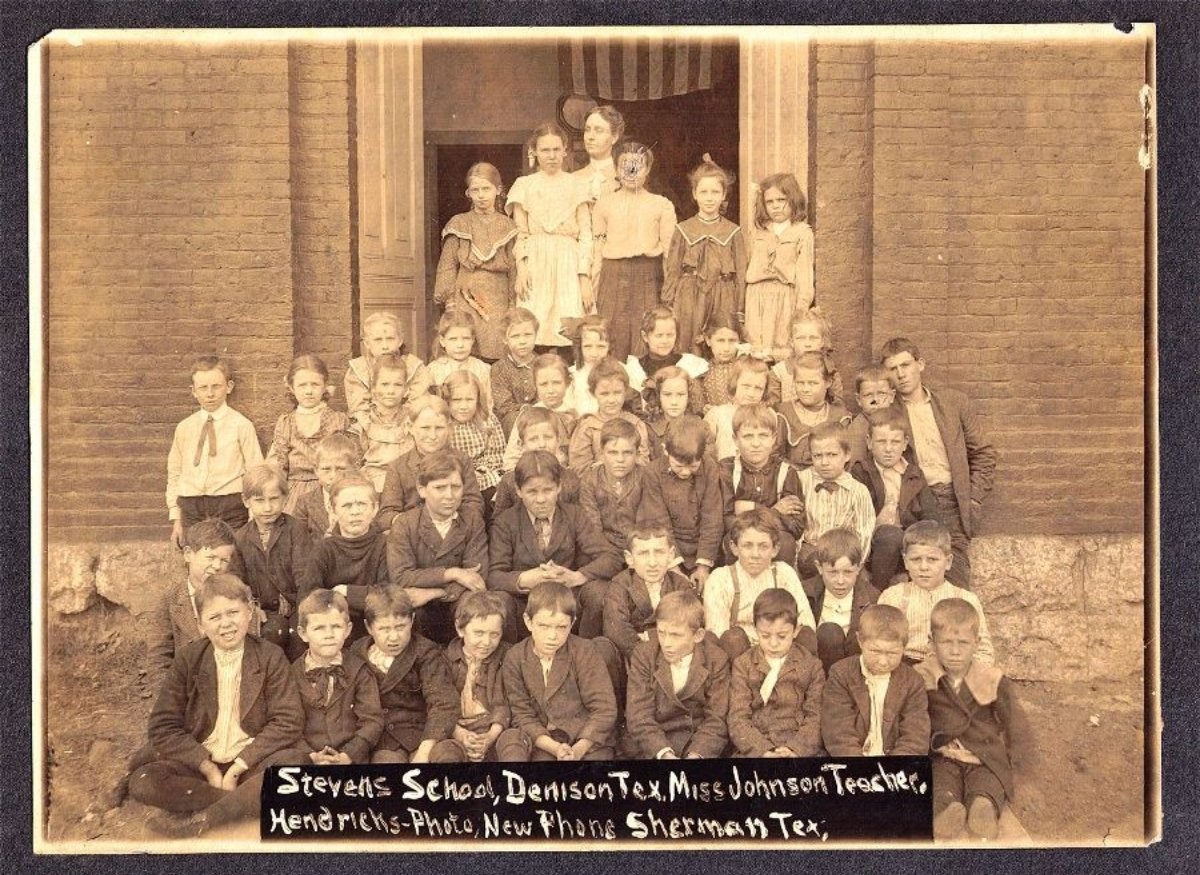


Cotton Mill Girl: a tribute to Hedy West Cotton Mill History Copyright © 2025, TXGenWeb. If you find any of
Grayson County, TXGenWeb links inoperable,
|

